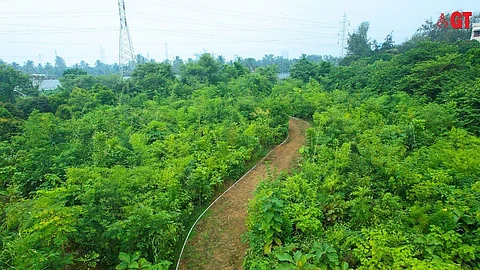

At a time when climate change is a critical issue and increasing green cover is crucial, Goa’s Mopa Airport is contributing to the fight against global warming.
Earlier this year, over 50,000 saplings of native species were planted across 6 acres of land at Manohar International Airport, at Mopa in Goa, using the innovative Miyawaki Plantation Method.
The plantation drive at Manohar International Airport was led by RK Nair, renowned as the ‘Green Hero of India’ and the father of the Miyawaki Plantation method in the country. He has planted over 3 million trees across 121 mini forests in 12 states using the Miyawaki technique.
“Around 51,000 saplings of over 30 native species were planted at Manohar International Airport Goa in June 2024. This plantation was carried out over 6 acres of land within the airport,” explained Nair.
“This mini forest within Manohar International Airport will eventually help not only in removing over 12,50,000 kg of carbon annually from the environment, but will also release over 51,00,000 kg of oxygen annually, making Goa’s air more clean and pure," he said.
"It will also help in restoring the ground water table and reduce the atmospheric temperature in nearby regions,” he added.
HOW THEY DID IT
Before planting, the list of local indigenous species to be used at the airport was shared with the Forest Department for review. The species were selected with consideration to their growth, ensuring that, once fully mature, the trees would have a 30 cm girth and reach a height of 35-40 feet within 5 years.
Additionally, the trees were chosen to avoid attracting birds or creating nesting sites, as they would be planted in an airport.
The plantation process involved ploughing the land to a depth of 600 mm using an excavator, removing boulders and highly lateritic soil from the beds where necessary, and adding good soil where required.
Following this, plantation beds and maintenance walkways were created. The plantation beds are 18 feet wide, with maintenance walkways between them measuring 4 feet in width.
The plantation drive at Manohar International Airport was led by RK Nair, renowned as the ‘Green Hero of India’ and the father of the Miyawaki Plantation method in the country.
Saplings of selected indigenous species, ranging from 1 to 3 feet in height, were procured for planting.
Additionally, materials such as a bio-material mix (bio-mass), which includes cocopeat, vermicompost and rice husk, were acquired to be used as fertiliser. Dry grass was also obtained for use as mulch.
Mulching involves covering the topsoil with plant materials such as leaves, grass, twigs, crop residues and straw.
This practice helps reduce evaporation, maintain a consistent soil temperature, prevent erosion, control weeds, and enrich the soil by enhancing the activity of beneficial soil organisms, including earthworms.
Bamboo sticks were procured to serve as support for the saplings. To ensure proper irrigation, a pipeline spanning over 3.5 km was installed, providing water to the saplings through an internal overhead impact sprinkler system.
The species were selected with consideration to their growth, ensuring that, once fully mature, the trees would have a 30 cm girth and reach a height of 35-40 feet within 5 years.
After the successful plantation of the saplings, the maintenance required included regular watering, consistent de-weeding, and ensuring the bamboo supports remain in place to help the saplings grow straight.
These saplings are maintained by a team of experts from RK Nair’s team along with support from Manohar International Airport. So far, the survival rate of the saplings has been very high.
This method has been gradually making its inroads in Goa. In 2021, it was used by Vedanta's Value-Added Business (VAB) to create a plantation in and around Amona and Navelim villages.
ABOUT MIYAWAKI PLANTATION METHOD
The Miyawaki Plantation Method is a Japanese technique, and is one of the most effective tree planting methods for creating forest cover quickly on land that has been used for other purposes, such as agriculture or construction.
It is effective because it is based on natural reforestation principles, i.e. using trees native to the area and replicating natural forest regeneration processes.
One of the most noticeable advantages in a Miyawaki forest is that the seedlings are planted at very high densities. This replicates the regeneration process that occurs in a natural forest.
The saplings grow very fast to compete for light, and then, natural selection favours the fastest growing ones and act to thin out the trees.
The result is a densely packed pioneer forest that grows in 20 to 30 years, instead of taking 150 to 200 years, thereby capturing more carbon very quickly.